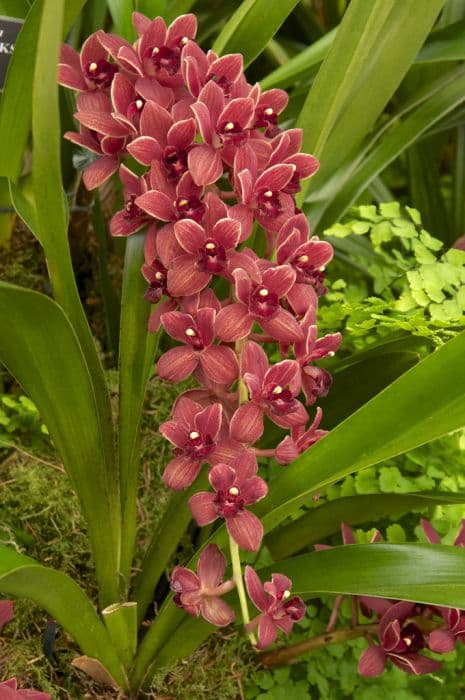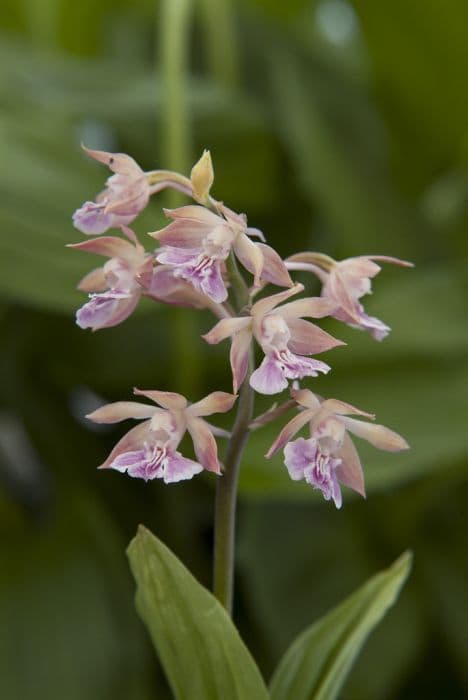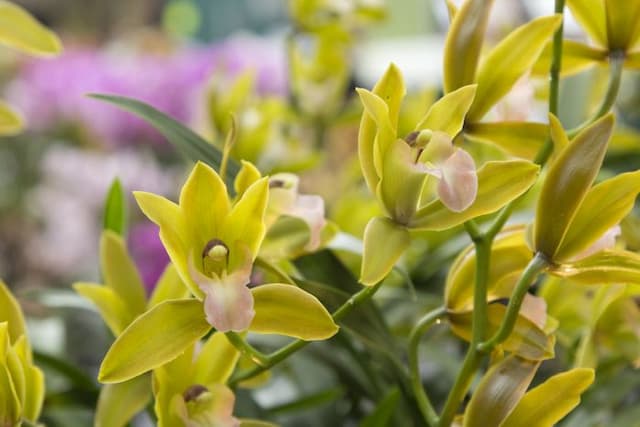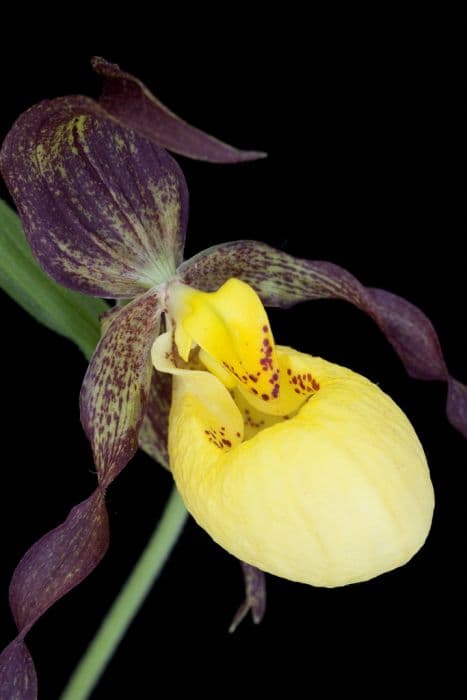Maud's Paphiopedilum Paphiopedilum Maudiae gx

ABOUT
The Paphiopedilum Maudiae gx, commonly known as the "Maudiae-type Paphiopedilum," is a charming and exotic orchid with a distinct appearance. This plant boasts a striking floral display, typically consisting of a prominent, slipper-shaped lower petal called a pouch. The pouch serves as a visual and structural lure for pollinators, exhibiting rich colors that range from deep green and burgundy to sometimes nearly blackish hues, often complemented by mottled or speckled patterns. The upper petals and sepals contrast with the pouch and are usually long and narrow, sometimes wavy at the edges, and can exhibit similar coloration and patterning. The surface of the unique slipper-shaped pouch is waxy and glossy, adding to the plant's visual appeal. The texture of the petals can vary, often being slightly ruffled or sometimes smooth, but always maintaining a delicate and sophisticated aesthetic. The leaves of the Maudiae-type Paphiopedilum are equally distinctive, with a deep, rich green color and a typically mottled appearance that resembles the camouflage of a military uniform. These leaves are broad, strap-like, and grow in a rosette pattern, creating an attractive base for the floral display above. The foliage tends to have a leathery texture, giving it a robust and hearty look. Despite being an orchid, this plant does not require the same type of support many orchids do, as it is not a climber nor an epiphyte that needs to attach to trees. Instead, it grows directly from the ground or in a potting medium, depending on its cultivation environment. This characteristic adds to its versatility and popularity among orchid enthusiasts, as it can be more easily accommodated in a variety of growing conditions. The Maudiae-type Paphiopedilum's blossom can be a single dramatic flower or may consist of a few flowers on a single spike, each bloom commanding attention with its intricate beauty and unusual form. Its dramatic and sophisticated appearance makes it a favorite among collectors and those looking to add a touch of drama to their indoor gardens or greenhouse collections.
About this plant
 Names
NamesFamily
Orchidaceae.
Synonyms
Maud's Paphiopedilum, Lady's Slipper Orchid, Venus Slipper, Maudiae Paph.
Common names
Paphiopedilum Maudiae gx.
 Toxicity
ToxicityTo humans
The plant known as the Lady Slipper Orchid is not typically considered toxic to humans. There are no well-documented cases of poisoning from ingesting any part of this plant.
To pets
The Lady Slipper Orchid is also not known to be toxic to pets. It is generally considered safe, and there should be no symptoms of poisoning in pets resulting from ingesting this plant. However, it is always advisable to prevent pets from eating plants as a precautionary measure.
 Characteristics
CharacteristicsLife cycle
Perennials
Foliage type
Evergreen
Color of leaves
Varies
Flower color
Mixed
Height
1-2 feet (30-60 cm)
Spread
1 foot (30 cm)
Plant type
Herb
Hardiness zones
9
Native area
Southeast Asia
Benefits
 General Benefits
General Benefits- Decorative Appeal: The Paphiopedilum Maudiae gx, commonly known as Lady's Slipper orchid, features distinctive pouch-shaped blooms that add an exotic touch to any indoor space.
- Long Blooming: Lady's Slipper orchids are known for having a long blooming period, which can last from weeks to even months, offering prolonged enjoyment.
- Psychological Well-being: Caring for plants like the Lady's Slipper orchid can reduce stress, enhance mood, and promote a sense of accomplishment.
- Interior Design Versatility: Their unique appearance allows them to be a focal point in a variety of interior design themes from modern to classic.
- Hobby Potential: Growing orchids can become a rewarding hobby, offering an opportunity for learning and specialization in orchid care and propagation.
- Conservation Awareness: Interest in orchid cultivation, including the Lady's Slipper, raises awareness about the need to conserve their wild counterparts and habitats.
 Medical Properties
Medical PropertiesThis plant is not used for medical purposes.
 Air-purifying Qualities
Air-purifying QualitiesThis plant is not specifically known for air purifying qualities.
 Other Uses
Other Uses- Photography Subject: With its striking flowers, the Paphiopedilum Maudiae, commonly known as Lady Slipper Orchid, is often used as a subject in macro and botanical photography.
- Educational Model: Botany teachers may use the flower to explain orchid pollination mechanisms due to its unique pouch-like labellum.
- Art Inspiration: Artists may draw inspiration from the Lady Slipper Orchid's unique shape and vibrant colors for paintings, illustrations, and textile designs.
- Feng Shui: Some practitioners use this orchid for Feng Shui to encourage tranquility and positive energy throughout the home or office.
- Eco-Friendly Gifts: As a sustainable plant that can bloom for several months, it is often given as an eco-friendly gift option.
- Cultural Ceremonies: In some cultures, orchids like the Lady Slipper are used in ceremonies as symbols of beauty and refinement.
- Wedding Decor: Incorporating the Paphiopedilum Maudiae into wedding bouquets or centerpieces can add a touch of exotic elegance to the event.
- Fashion Accessories: Real or silk replicas of the Lady Slipper Orchid are sometimes used as ornate hair accessories or corsages.
- Biodiversity Studies: The plant can be used in research and education to illustrate biodiversity and the importance of conservation efforts.
- Interior Decorating: Live orchids or stylized representations of the Lady Slipper can serve as striking interior décor elements in homes and businesses.
Interesting Facts
 Feng Shui
Feng ShuiThe Lady Slipper Orchid is not used in Feng Shui practice.
 Zodiac Sign Compitability
Zodiac Sign CompitabilityThe Lady Slipper Orchid is not used in astrology practice.
 Plant Symbolism
Plant Symbolism- Exotic Beauty: The Lady Slipper Orchid, which Paphiopedilum Maudiae gx is a hybrid of, is often associated with exotic beauty due to its unique and striking appearance.
- Rarity: This plant symbolizes rarity and uniqueness, as it is not commonly found and its growth requirements are very specific.
- Femininity: The Lady Slipper Orchid is reminiscent of a woman's slipper, and thus it's associated with femininity and grace.
- Capriciousness: The plant can be challenging to grow, which symbolizes capriciousness and the idea that beauty often requires effort and special care.
 Water
WaterLady Slipper Orchids, the common name for Paphiopedilum Maudiae, should be watered regularly to keep the potting mix evenly moist but not waterlogged. Typically, watering once a week is sufficient, but this can vary depending on the humidity and temperature of your growing environment. It's important to water with about one cup (8 ounces) of water when the top inch of the potting medium feels dry to the touch. Avoid letting the plant sit in water, as this can lead to root rot. During the dormant period, usually in winter, reduce watering frequency.
 Light
LightLady Slipper Orchids thrive in moderate light conditions without direct sunlight. Bright, indirect light is best, so a spot near a north or east-facing window would be ideal. They can also be grown under fluorescent lighting, making them suitable for locations that don't receive a lot of natural light. Avoid placing them in direct sun as it can burn the foliage.
 Temperature
TemperatureLady Slipper Orchids prefer temperatures between 60 and 80 degrees Fahrenheit during the day and a slight drop to 50-65 degrees Fahrenheit at night. These orchids can tolerate a minimum temperature of 50 degrees Fahrenheit, but they should not be exposed to temperatures below this, as it could damage the plant. The ideal temperature range supports healthy growth and bloom.
 Pruning
PruningLady Slipper Orchids do not require extensive pruning, but it's beneficial to remove yellowing or dead foliage to maintain the plant's health and appearance. Pruning can be done at any time of year as needed. After the flower has faded, the flower stems can be cut back to the base to encourage new growth. Pruning should be done with sterilized scissors or pruning shears to prevent the spread of disease.
 Cleaning
CleaningAs needed
 Soil
SoilLady Slipper Orchid thrives in a soil mix containing bark, perlite, and charcoal, with good drainage and aeration properties. The preferred soil pH for this orchid is slightly acidic to neutral, ranging from 5.5 to 7.0.
 Repotting
RepottingLady Slipper Orchids should be repotted every one to two years, ideally during the spring after the blooming season when the plant starts producing new growth.
 Humidity & Misting
Humidity & MistingLady Slipper Orchid requires high humidity levels, ideally between 40% and 70%, to thrive and maintain healthy growth.
 Suitable locations
Suitable locationsIndoor
Keep in moderate light, high humidity, and avoid direct sun.
Outdoor
Shelter from direct sun; provide dappled shade and humidity.
Hardiness zone
9-12 USDA
 Life cycle
Life cycleThe Paphiopedilum Maudiae, commonly known as "Lady's Slipper Orchid," begins its life as a seed, which is tiny, dust-like, and requires a symbiotic relationship with a mycorrhizal fungus to germinate. Once germinated, it develops into a protocorm, a primitive plant form that eventually grows into a young orchid plant. This juvenile stage involves the development of leaves and a root system, during which the plant focuses on gathering energy through photosynthesis and slowly matures. The plant reaches maturity and enters its reproductive phase after several years, producing distinctive slipper-shaped flowers that can emerge from a central spike and may last for several weeks. After pollination, which is often facilitated by insects attracted to the flower, the plant produces a seed capsule containing numerous seeds, thus continuing the reproductive cycle. During its life, the Paphiopedilum Maudiae goes through periods of growth and dormancy, typically with growth in the warmer months and dormancy in the cooler season, requiring particular attention to watering and light during these stages to maintain health and encourage blooming.
 Propogation
PropogationPropogation time
Spring-Early Summer
Paphiopedilum Maudiae, commonly known as Maudiae Paph or Lady Slipper Orchid, can be propagated by dividing the plant during repotting, usually done in spring or autumn when the plant is not in active growth. The most popular method of propagation is division, which involves carefully separating the plant's offsets, which are the small plantlets or shoot clumps that develop at the base of the parent plant. To do this, remove the orchid from its pot and gently tease apart the roots to find natural divisions where the plant can be separated. Each division should have at least three healthy roots and one growth point to ensure it can grow into a successful new plant. Once separated, pot each division in its own container with appropriate orchid potting mix and maintain a humid environment with indirect light to encourage growth.









